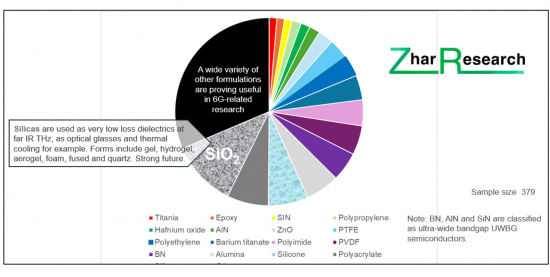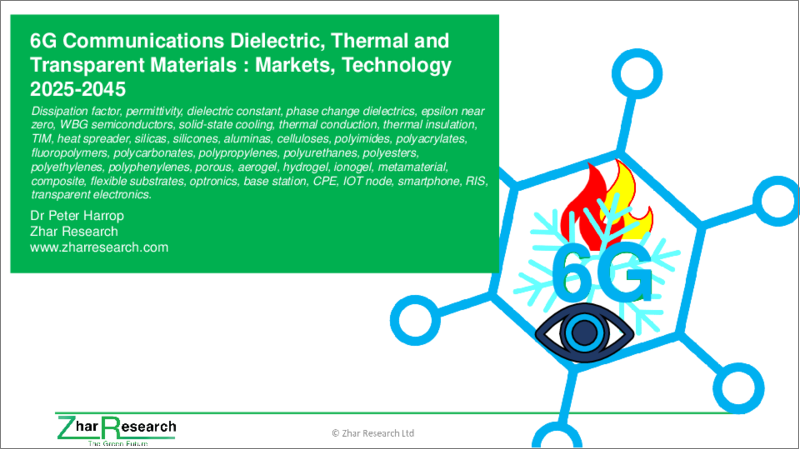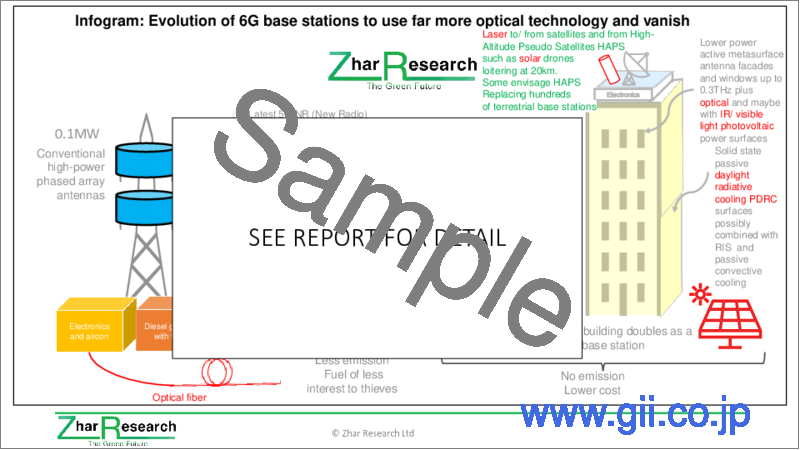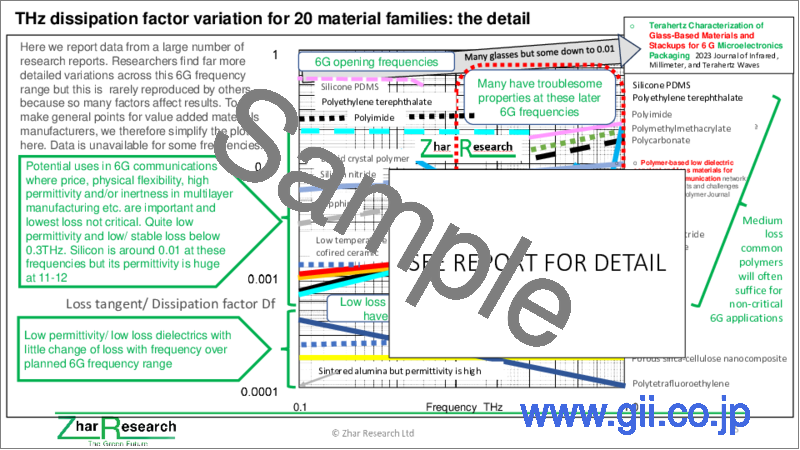|
|
市場調査レポート
商品コード
1548194
6G通信の誘電体・熱材料・透明材料:市場と技術 (2025-2045年)6G Communications Dielectric, Thermal and Transparent Materials: Markets, Technology 2025-2045 |
||||||
|
|||||||
| 6G通信の誘電体・熱材料・透明材料:市場と技術 (2025-2045年) |
|
出版日: 2024年08月31日
発行: Zhar Research
ページ情報: 英文 432 Pages
納期: 即日から翌営業日
|
全表示
- 概要
- 目次
無線通信の各世代はトランスミッションの周波数を上げることで性能を向上させています。6Gでは、ワイドバンドギャップ半導体と、特に誘電体が要求されます。例えば、信号を伝達するリレーは、フレキシブル誘電体基板上の相変化誘電体でチューニングされたメタサーフェスになります。6Gでは、光誘電体を使ったワイヤレス遠赤外トランスミッションへと進化します。
新しい世代になるごとに、より多くの熱を発生するインフラが採用されるため、冷却が重要となり、特に誘電体をベースとした新しい固体冷却が注目されます。また、インフラやクライアントデバイスの自己給電には、WBGや誘電体を使用したサーモエレクトリックや光起電力が採用されます。ハードウェアはますます透明化され、受け入れられやすくなり、性能も向上しています。大きな機会は、誘電体、超広帯域UWBG半導体、熱材料、透明性といったトピックにあると考えられています。
| 章構成: | 8章 |
| SWOT評価: | 16項目 |
| 予測ライン: | 30ライン |
| インフォグラム: | 67個 |
| 企業数: | 107社 |
| ページ数: | 432ページ |
当レポートでは、6G通信の誘電体・熱材料・透明材料の技術と市場を調査し、6Gにおける誘電体・熱材料・透明材料の重要性、主要材料のR&D動向、技術ロードマップ、主要材料の市場規模の推移・予測、6Gの付加価値材料とデバイス製造技術に携わる中小企業などをまとめています。

目次
第1章 エグゼクティブサマリー・総論:2025~2045年のロードマップ・予測ライン
第2章 イントロダクション
- 概要、焦点、情勢インフォグラム
- 6Gフェーズ1は段階的に
- 6G第2フェーズは混乱を招き、極めて困難になる
- 多くの光学機能の重要性を示す6G材料のニーズとツールキット
- 補完的な6G周波数の選択
- 6G再構成可能インテリジェントサーフェスRISの進化
- 6G RISのSWOT評価
- 6G基地局の進化
- 6G用資材・機器メーカー例
第3章 6G熱管理材料と用途
- 概要、温度制御の課題、将来の技術ツールキット
- 6G通信熱材料の機会のSWOT評価
- 6Gにおける熱伝導材料の需要増加によりさらなるイノベーションが求められる:市場ギャップ
- 熱課題を解決する際に考慮すべき重要な点
- 新しい熱伝導性ポリマーと複合材料:2024年の進捗状況
- 2025~2045年に出現する熱材料の選択肢:メタマテリアル、ハイドロゲル、エアロゲル、イオノゲル、熱分解グラファイト
- 熱管理構造
第4章 誘電体、熱伝導材、透明材料を使用した6G向け固体冷却
- 概要
- 11の主要な結論
- ソリッドステート冷却の定義と必要性
- 最近の研究発表211件で、将来の固体冷却に最も必要とされる化合物が明らかに
- 12のソリッドステート冷却の動作原理を10の機能別に比較
- トピック別および技術成熟度別の固体冷却の研究パイプライン
- 新興の固体冷却の核心
- 固体冷却と加熱防止の機能と形式
- 熱伝導材料やその他の冷却の将来
- シリコーン熱伝導材料のSWOT評価
- ソリッドステート冷却全般のSWOT評価と、2024年に大幅な進歩が報告される7つの新バージョン
- 2024年の6Gチップ、レーザー、基地局ビルの多機能用途向け熱電温度制御材料
- 冷却技術の注目度と成熟度の3つの曲線:2025年、2035年、2045年
第5章 非可視性が受容と性能の問題を解決:透明パッシブ反射アレイとオールラウンドSTAR RIS
- 2024年の概要と事例
- 2024-5年の6G伝送処理面の透明化の状況
- 視覚的に透明または不透明にできる6Gビーム処理面のオプション
- 透明なIRSとRISはほぼどこにでも行ける
- 透明パッシブインテリジェント反射面IRS:Meta Nanoweb-R Sekisui
- 光学的に透明で透過性のあるミリ波およびテラヘルツRIS
- 同時透過・反射型STAR RIS
- STAR RISのSWOT評価
- その他の研究論文:2024年
- その他の研究論文:2023年
第6章 6G通信のメタマテリアルの基礎、トランスミッション、エネルギー回収など
- 概要と潜在的な用途、2024年の進歩
- インフォグラム:5Gと6Gにおけるメタマテリアルの位置づけ
- 6Gで検討されている電磁メタマテリアルのクラス
- 5Gおよび6G通信向けメタマテリアル反射アレイとRIS
- 2024年の主要な進歩を含むメタマテリアルのパターンと材料
- 6G RISウィンドウを含む二機能メタサーフェスを含む超曲面
- メタサーフェス6Gエネルギーハーベスティング:2024年の目覚ましい研究の進歩
- 2024年に7つの進歩を遂げる6G向け調整可能メタマテリアル
- GHz、THz、赤外線、可視光メタマテリアルの多くの新しい用途が投資リスクを軽減
- メタマテリアルとメタサーフェスのSWOT評価
- メタマテリアル全体の長期的展望
第7章 6G 0.3THzから可視光6Gトランスミッションのための誘電体、光学材料、半導体
- 誘電体の定義、6Gの有用性、リスク回避、2024年以降の研究進展の例
- 高誘電率および低誘電率6G低損失材料の探求
- 6G向けの重要な誘電体配合の登場
- 6Gオプトロニクス向け相変化誘電体、液晶および代替品
- テラヘルツ導波ケーブルおよび小型ユニット
- 6G向け近赤外線光ファイバーの将来
第8章 6Gの付加価値材料とデバイス製造技術に携わる中小企業
- AALTO HAPS (英国・ドイツ・フランス)
- Echodyne (米国)
- Evolv Technology (米国)
- Fractal Antenna Systems (米国)
- Greenerwave (フランス)
- iQLP (米国)
- Kymeta Corp. (米国)
- LATYS Intelligence (カナダ)
- Meta Materials (カナダ)
- Metacept Systems (米国)
- Metawave (米国)
- Pivotal Commware (米国)
- SensorMetrix (米国)
- Teraview (米国)
Summary
Time for a report on 6G dielectrics, thermal and transparent materials. Why? Each generation of wireless communication increases performance by increasing transmission frequency. With 6G, that demands wide bandgap WBG semiconductors and particularly dielectrics. For example, the relay passing on the signal becomes a metasurface tuned with phase change dielectric on a flexible dielectric substrate as one option. 6G will evolve to add wireless far infrared transmission using optical dielectrics.
Every new generation employs more infrastructure generating more heat so cooling comes center stage, notably the new solid-state cooling based on dielectrics, and self-powering of infrastructure and client devices employs thermoelectrics and photovoltaics using WBG and dielectrics. Hardware increasingly becomes transparent to be acceptable (invisible facade overlayers, smart windows) and better performing (360-degree reconfigurable intelligent surfaces). Your big opportunity pivots to the overlapping topics of dielectrics, ultra-wide bandgap UWBG semiconductors, thermal materials and transparency and only this report covers them all. Vitally, it analyses the flood of advances in 2024, forecasting 2025-2045 because so much has changed recently.
Commercially oriented, the report has:
| Chapters: | 8 |
| SWOT appraisals: | 16 |
| Forecast lines: | 30 |
| Infograms: | 67 |
| Companies: | 107 |
| Pages: | 432 |
"6G Communications Dielectric, Thermal and Transparent Materials : Markets, Technology 2025-2045" starts with an Executive Summary and Conclusions clearly pulling everything together for those with limited time. Those 26 pages are mainly lucid new infograms, the 13 key conclusions and 2025-2045 roadmaps. The 30 forecast lines then add pages as both tables and graphs. The 41-page Introduction gives a thorough background to 6G hardware with SWOT appraisals and introduces some 2024 research.
Flood of 2024 research analysed
Then come two large chapters on your thermal materials and device opportunities in the light of breakthroughs in 2024 with a large amount of 2024 research analysed. Chapter 3 "6G thermal management materials and applications" (94 pages) presents the overall thermal picture, with the latest view of needs matched to the latest toolkit. That includes new thermally conductive polymers and composites, thermal metamaterial, hydrogel, aerogel, ionogel, pyrolytic graphite and graphene for both 6G infrastructure and client devices. There is even deep coverage of thermal systems you may wish to supply.
6G cooling becomes a large opportunity
Cooling emerges as the major thermal requirement due to 6G infrastructure making more heat and requiring client devices to manage heat in smaller formats. Indeed, emerging markets are in hotter places such as India and global warming also contributes to the 6G cooling problem. Conventional vapor compression cooling heats cities by up to several degrees and is not fit-and-forget so attention turns to solid state cooling for 6G merging with its hosts such as high-rise buildings and loitering stratospheric drones.
Consequently, a dedicated Chapter 4, "Solid state cooling for 6G using dielectric, thermal and transparent materials" (35 pages) analyses this favourite for infrastructure and client devices on the 20-year view. See eleven primary conclusions, most needed compounds for future solid-state cooling in 211 recent research announcements and twelve solid-state cooling operating principles compared by 10 capabilities. The research pipeline of solid-state cooling by topic vs technology readiness level is presented in three new maturity curves 2025, 2035, 2045. Thermal interface materials, thermoelectric, caloric, passive daytime radiative and other cooling principles are covered. Interestingly, your ultra-WBG materials such as SiN, AlN, BN and dielectrics such as silicas and aluminas are here need for cooling but later identified for many other 6G uses as well. It is found that solid state cooling suitable for 6G mainly needs inorganics whereas the other needs addressed in the report mainly need identified polymers.
Invisibility
Invisible 6G infrastructure will be more acceptable and functional from solar drones at 20km to satellites and transparent materials and devices, two major types being covered in Chapter 5, "Invisibility solves acceptance and performance problems: Transparent passive reflect-arrays and all-round STAR RIS", its 32 pages including two SWOT appraisals and a large amount of research progress in 2024.
Dielectric multifunctional metamaterials
Chapter 6, "Metamaterial basics, transmission, energy harvesting and more for 6G communications" takes 20 pages the assess a large amount of 2024 advance and give a SWOT appraisal. Understand why 6G demands progress from metal patterning on epoxy laminate to flexible, transparent, self-cleaning - even all dielectric - metamaterials for making 6G photovoltaics follow the sun and keep cool and for handling THz, near IR and visible light. See the remarkable research progress in 2024 achieving just that and also making electricity from movement, useful in 6G client devices.
Optical transmission materials and devices emerging
Then comes a large Chapter 7, "Dielectrics, optical materials, semiconductors for 6G 0.3THz to visible light 6G transmission" at 109 pages. Mostly dielectrics, it also includes ultra-wide gap semiconductors coming in and the flood of new research progress on all these topics. Overall, the important performance parameters are identified and, for dielectrics, a very detailed look at permittivities and dissipation factors DF for 20 dielectric families at the higher 6G frequencies. Matched against needs, it reveals that the emerging market for dielectrics with intermediate DF, low permittivity such as polyimides will be large, that for low DF, low permittivity such as porous silicas will be significant but there will also be a market for high permittivity, low DF such as hafnium oxide. What about Fluoropolymers (PBVE, PTFE, PVDF), epsilon near zero materials, THz and optical tuning materials? It is all here with a host of 2024 research advances and latest views.
Partners and acquisitions
To save time, you will need partners and acquisitions, mostly small companies, so the final Chapter 8, "Some small companies involved in 6G added value material and device manufacturing technologies" in 40 pages, profiles 14 for you to consider.
An important takeaway from, "6G Communications Dielectric, Thermal and Transparent Materials : Markets, Technology 2025-2045" is that the most successful materials in research for 6G thermal, dielectric and transparent applications have exceptionally varied morphologies, formats and applications in the preferred solid-state phase and are useful in many new composites. Overall, they are fairly-evenly divided between inorganics and organics with a trend to multifunctional smart materials using both.
Caption: Thermal, dielectric, UWBG materials of interest for 6G: latest research priorities. Source: Simplified image from Zhar Research report, "6G Communications Dielectric, Thermal and Transparent Materials : Markets, Technology 2025-2045".

Table of Contents
1. Executive Summary and Conclusions with roadmaps and forecast lines 2025-2045
- 1.1. Purpose of this report
- 1.2. Methodology of this analysis
- 1.3. Key conclusions: What will drive 6G success, landscape infogram
- 1.4. 6G hardware vanishing acceptable, affordable: implications, opportunities
- 1.5. Key conclusions: 6G materials generally
- 1.6. Key conclusions: thermal materials for 6G with four infograms
- 1.7. Key conclusions: dielectrics for 6G with five infograms
- 1.8. Organisations developing 6G hardware and likely purchasers of 6G added value materials
- 1.9. Technology roadmaps 2025-2045 and market forecast lines 2025-2045
- 1.9.1. Assumptions
- 1.9.2. Roadmaps of 6G materials and hardware 2025-2045
- 1.10. Market forecasts for 6G dielectric and thermal materials 2025-2045: tables with graphs
- 1.10.1. Dielectric materials market for 6G $ billion 2024-2045
- 1.10.2. Low loss materials for 6G area million square meters 2024-2045
- 1.10.3. Low loss materials for 6G value market % by frequency in two categories 2029-2045
- 1.10.4. Dielectric and thermal materials for 6G value market % by location 2029-2045
- 1.10.5. Thermal management material and structure for 6G Communications infrastructure and client devices $ billion 2025-2045
- 1.10.6. 5G vs 6G thermal interface material market $ billion 2024-2045
- 1.11. Background forecasts 2025-2045: tables with graphs
- 1.11.1. Market for 6G vs 5G base stations units millions yearly 2024-2045
- 1.11.2. Market for 6G base stations market value $bn if successful 2025-2045
- 1.11.3. 6G RIS value market $ billion: active and three semi-passive categories 2029-2045
- 1.11.4. 6G fully passive transparent metamaterial reflect-array market $ billion 2029-2045
- 1.11.5. 6G infrastructure/ client device market for materials manipulating IR and visible light: four categories $ billion 2029-2045
- 1.11.6. 6G infrastructure and device market for materials manipulating IR and visible light $ billion 2029-2045
- 1.11.7. Smartphone billion units sold globally 2023-2045 if 6G is successful
2. Introduction
- 2.1. Overview, reason for focus of this report and landscape infograms
- 2.1.1. Overview
- 2.1.2. Importance of dielectric, thermal and transparent materials and devices for 6G
- 2.1.3. Infograms: Planned 6G hardware deployment by land, water, air
- 2.2. 6G Phase One will be incremental
- 2.2.1. Overview
- 2.2.2. New needs, 5G inadequacies, massive overlap 4G, 5G, 6G
- 2.3. 6G Phase Two will be disruptive and extremely difficult
- 2.3.1. Overview
- 2.3.2. Some objectives of 6G mostly not achievable at start
- 2.3.3. View of a Japanese MNO heavily involved in hardware
- 2.3.4. ITU proposals and 3GPP initiatives also go far beyond what is achievable at start
- 2.3.5. Ultimate objectives and perceptions of those most heavily investing in 6G
- 2.4. Some 6G material needs and toolkit showing importance of many optical functions
- 2.5. Choosing complementary 6G frequencies
- 2.5.1. Overview
- 2.5.2. How attenuation in air by frequency and type 0.1THz to visible is complementary
- 2.5.3. Infogram: The Terahertz Gap and optics demands 6G RIS tuning materials and devices different from 5G
- 2.5.4. Spectrum for 6G Phase One and Two in context of current general use of spectrum
- 2.5.5. Essential frequencies for 6G success and some hardware resulting
- 2.6. Evolution of 6G reconfigurable intelligent surfaces RIS
- 2.6.1. Multifunctional and using many optical technologies
- 2.6.2. Infogram: RIS specificity, tuning criteria, physical principles, activation options
- 2.6.3. 6G RIS tuning material benefits and challenges compared
- 2.6.4. RIS will become zero energy devices and they will enable ZED client devices
- 2.6.5. Examples of 2024 research advances with far infrared THz RIS
- 2.6.6 6G RIS SWOT appraisal
- 2.7. Evolution of 6G base stations
- 2.7.1. Trend to use more optical technology
- 2.7.2. 6G Self-powered ultra-massive UM-MIMO base station design
- 2.8. Examples of manufacturers of 6G materials and equipment
- 2.8.1. Across the landscape infogram
- 2.8.2. Mapped across the globe
3. 6G thermal management materials and applications
- 3.1. Overview, temperature control challenges, future technology toolkit
- 3.2. SWOT appraisal of 6G Communications thermal material opportunities
- 3.3. Greater need for thermal materials in 6G demands more innovation: Gaps in the market
- 3.4. Important considerations when solving thermal challenges
- 3.5. New thermally conductive polymers and composites: 2024 progress
- 3.6. Thermal material options emerging 2025-2045: metamaterial, hydrogel, aerogel, ionogel, pyrolytic graphite
- 3.6.1. Thermal metamaterial with 11 advances in 2024
- 3.6.2. Thermal hydrogels including many advances in 2024
- 3.6.3. Ionogels for 6G applications: advances in 2024
- 3.6.5. Graphene-based thermal materials and structures including 2024 progress
- 3.7. Heat management structures
4. Solid state cooling for 6G using dielectric, thermal and transparent materials
- 4.1. Overview
- 4.2. Eleven primary conclusions
- 4.3. Definition and need for solid-state cooling
- 4.4. The most needed compounds for future solid-state cooling in 211 recent research announcements
- 4.5. Twelve solid-state cooling operating principles compared by 10 capabilities
- 4.6. Research pipeline of solid-state cooling by topic vs technology readiness level
- 4.7. Heart of emerging solid-state cooling
- 4.8. Function and format of solid-state cooling and prevention of heating
- 4.9. The future of thermal interface materials and other cooling by thermal conduction
- 4.10. SWOT appraisal for silicone thermal conduction materials
- 4.11. SWOT appraisals of solid-state cooling in general and seven emerging versions with radical advances reported in 2024
- 4.12. Thermoelectric temperature control materials for 6G chips, lasers, multifunctional use in base station buildings in 2024
- 4.13. Attention vs maturity of cooling technologies 3 curves 2025, 2035, 2045
- 4.14. Further reading
5. Invisibility solves acceptance and performance problems: Transparent passive reflect-arrays and all-round STAR RIS
- 5.1. Overview and examples in 2024
- 5.2. Situation with transparent 6G transmission-handling surfaces in 2024-5
- 5.3. Options for 6G beam-handling surfaces that can be visually transparent or opaque
- 5.4. Transparent IRS and RIS can go almost anywhere
- 5.5. Transparent passive intelligent reflecting surface IRS: Meta Nanoweb-R Sekisui
- 5.6. Optically transparent and transmissive mmWave and THz RIS
- 5.6.1. Overview
- 5.6.2. NTT DOCOMO transparent RIS
- 5.6.3. Cornell University RIS prototype and later work elsewhere
- 5.7. Simultaneous transmissive and reflective STAR RIS
- 5.7.1. Overview
- 5.7.2. STAR-RIS optimisation
- 5.7.3. STAR-RIS-ISAC integrated sensing and communication system
- 5.7.4. TAIS Transparent Amplifying Intelligent Surface and SWIPT active STAR-RIS
- 5.7.5. STAR-RIS with energy harvesting and adaptive power
- 5.7.6. Potential STAR-RIS applications including MIMO and security
- 5.8. STAR RIS SWOT appraisal
- 5.9. Other research papers analysed from 2024
- 5.10. Other research papers analysed from 2023
6. Metamaterial basics, transmission, energy harvesting and more for 6G communications
- 6.1. Overview and potential uses and some advances in 2024
- 6.2. Infogram: The place of metamaterials in 5G and 6G
- 6.3. Classes of electromagnetic metamaterial considered for 6G
- 6.4. Metamaterial reflect-arrays and RIS for 5G and 6G Communications
- 6.5. Metamaterial patterns and materials including major advances in 2024
- 6.6. Hypersurfaces including bifunctional metasurfaces including 6G RIS windows that cool
- 6.7. Metasurface 6G energy harvesting: Impressive research advances in 2024
- 6.8. Tunable metamaterials for 6G with seven advances in 2024
- 6.9. Many emerging applications of GHz, THz, infrared and visible light metamaterials derisking investment
- 6.10. SWOT appraisal of metamaterials and metasurfaces
- 6.11. The long-term picture of metamaterials overall
7. Dielectrics, optical materials, semiconductors for 6G 0.3THz to visible light 6G transmission
- 7.1. Dielectric definition, 6G usefulness, derisking, examples of research progress from 2024
- 7.1.1. Overview, important parameters, some latest examples and Zhar Research appraisal
- 7.1.2. Different dielectrics from 5G to 6G: better parameters, lower costs, larger areas
- 7.1.3. Important parameters for 6G dielectrics at device, board, package and RIS level: 5 infograms
- 7.1.4. Advances in 2024 and earlier with Zhar Research overall conclusions
- 7.1.5. SWOT appraisal of low-loss dielectrics for 6G infrastructure and client devices
- 7.1.6. Examples of new dielectrics being derisked by potential use both in 6G and other applications
- 7.2. The quest for high and low permittivity 6G low loss materials
- 7.2.1. Basic mechanisms affecting THz permittivity are challenging at 6G frequencies
- 7.2.2. Permittivity 0.1-1THz for 20 low loss compounds simplified
- 7.2.3. Dissipation factor optimisation across THz frequency for 20 material families
- 7.2.6. Special cases Epsilon Near Zero ENZ, silicon, phase change, electro-sensitive
- 7.2.4. THz dissipation factor variation for 20 material families: the detail
- 7.2.5. Compromises depending on format, physical properties and application
- 7.2.6. Special cases Epsilon Near Zero ENZ, silicon, phase change, electro-sensitive
- 7.3. Important dielectric formulations emerging for 6G including advances in 2024
- 7.3.1. Alumina including sapphire
- 7.3.2. Fluoropolymers PBVE, PTFE, PVDF
- 7.3.3. Polyimides
- 7.3.4. Polyphenylene ether and its polystyrene blends, polyphenylene oxide
- 7.3.5. Polypropylenes and their composites
- 7.3.6. Silica and its composites including quartz
- 7.4. Phase change dielectrics, liquid crystal and alternatives for 6G optronics
- 7.4.1. Overview
- 7.4.2. Status of 11 semiconductor and active layer candidates
- 7.4.3. Liquid crystal adopting many more 6G optronic roles: advantages, challenges
- 7.4.4. Vanadium dioxide adopting many more 6G optronic roles: advantages, challenges
- 7.5. Terahertz waveguide cables and small units
- 7.5.1. Need, and state of play
- 7.5.2. Advances in THz waveguides in 2025 (pre-publication), 2024 and 2023
- 7.5.3. Design and materials of 6G waveguide cables including fluoropolymers and polypropylenes
- 7.5.4 THz waveguides from InAs, GaP, sapphire etc. for boosting emitters, sensing etc.
- 7.5.5. Manufacturing polymer THz cable in long reels
- 7.5.6. THz waveguide gratings etched on metal-wires
- 7.5.7. SWOT appraisal of terahertz cable waveguides in 6G systems
- 7.6. Future near IR fiber optics for 6G
- 7.6.1. 5G experience
- 7.6.2. Fundamental types
- 7.6.3. Vulnerability of fiber optic cable: Serious attacks occurring
- 7.6.4. Limiting use of the fiber and its electronics to save cost
- 7.6.5. Fiber optic cable design and materials
- 7.6.6. SWOT appraisal of fiber optics in 6G system design
8. Some small companies involved in 6G added value material and device manufacturing technologies
- 8.1. AALTO HAPS UK, Germany, France
- 8.2. Echodyne USA
- 8.3. Evolv Technology USA
- 8.4. Fractal Antenna Systems USA
- 8.5. Greenerwave France
- 8.6. iQLP USA
- 8.7. Kymeta Corp. USA
- 8.8. LATYS Intelligence Canada
- 8.9. Meta Materials Canada
- 8.10. Metacept Systems USA
- 8.11. Metawave USA
- 8.12. Pivotal Commware USA
- 8.13. SensorMetrix USA
- 8.14. Teraview USA






